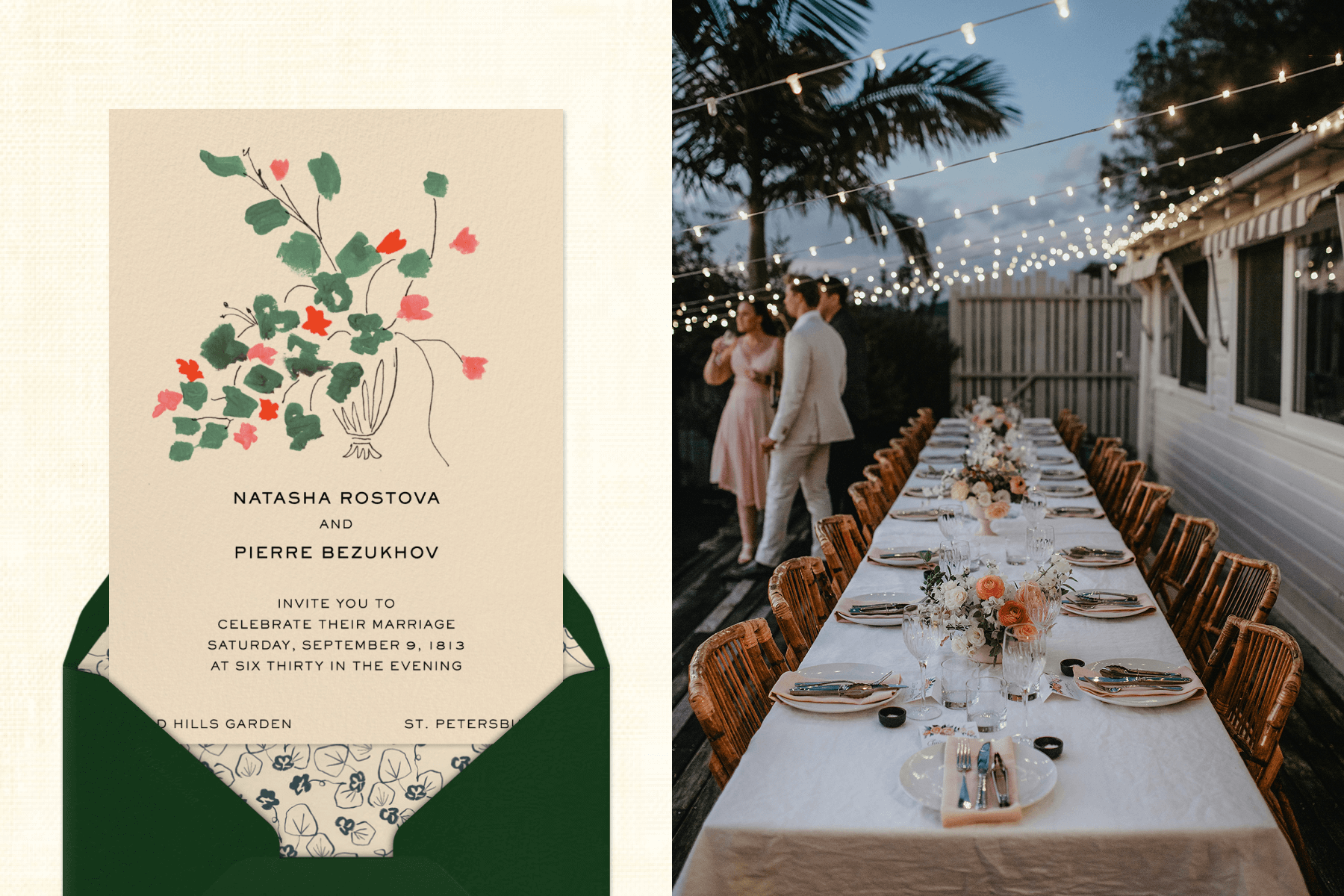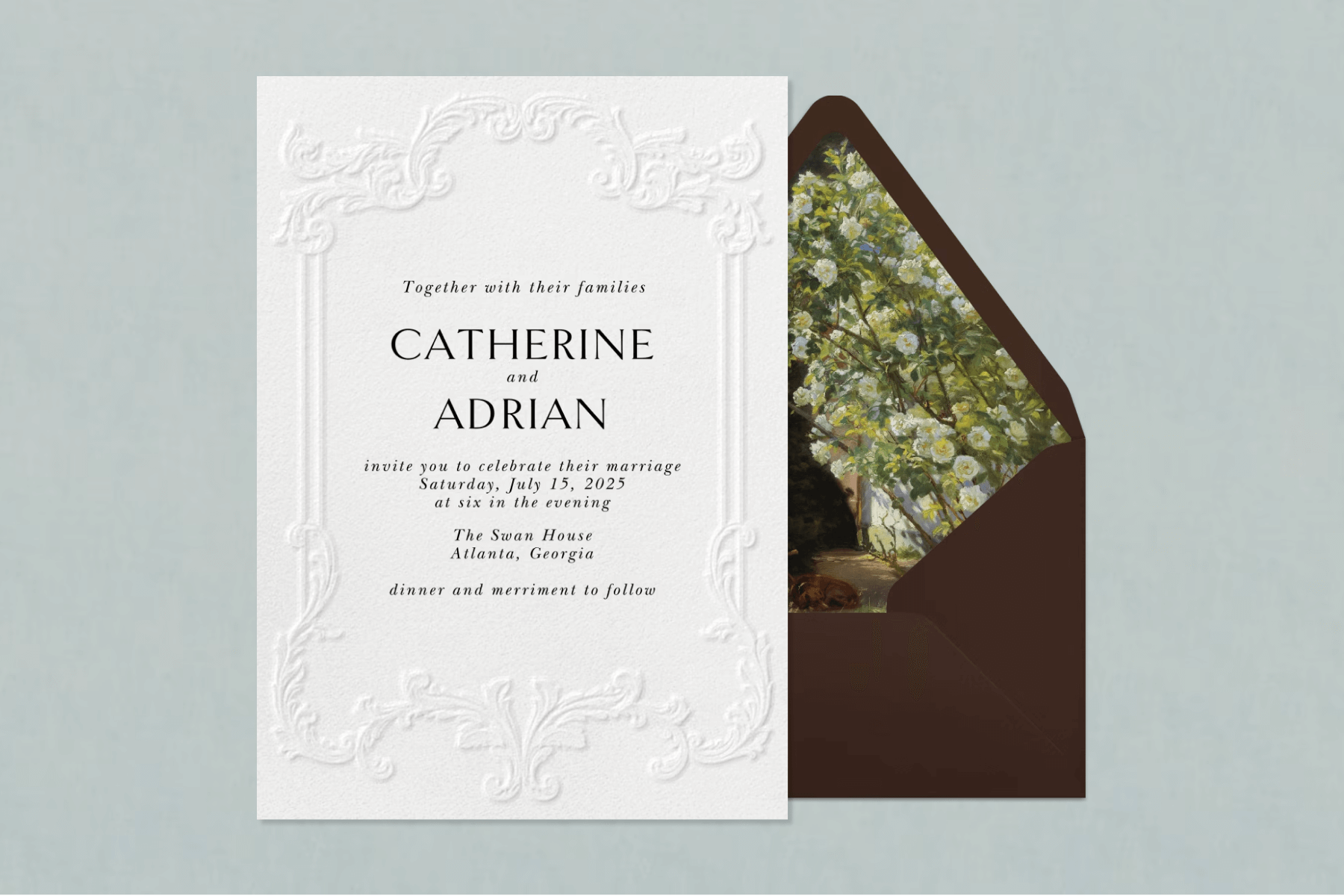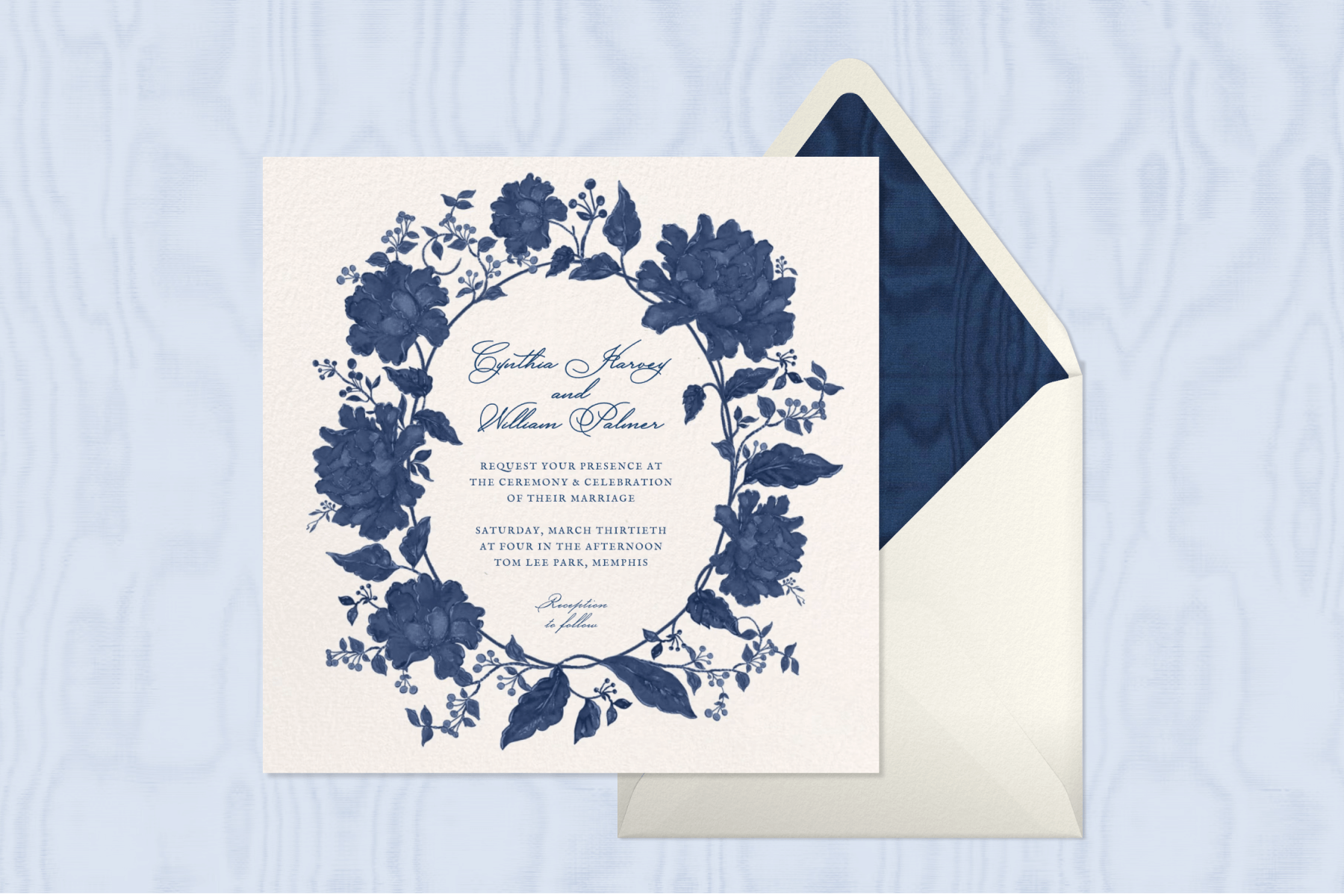How many people should you invite to your wedding?

Aside from the all-important “Will you marry me?”, planning a wedding comes with a cascade of exciting choices—like taste-testing decadent cakes, finding the dress, selecting personalized invitations that feel just like you, and picking the perfect venue. Some decisions are a no-brainer (divine double chocolate cake? Yes, please), but one question that tends to stop couples in their tracks is: How many people should you invite to your wedding?
If you’re feeling overwhelmed by your wedding guest list, you’re not alone. Whether you dream of an intimate celebration under the stars or envision the party of the decade with every friend, family member, and distant cousin in attendance, deciding who makes the list can be one of the most challenging parts of wedding planning. Fortunately, there are practical ways to figure out the right number of guests for your celebration.
There’s no magical formula for how many people to invite to a wedding, but understanding your priorities can guide you to the number that feels just right. (For reference, the average wedding guest count typically falls between 100 and 150 people.) We’ll walk you through the key considerations—like budget, venue size, and splitting up invites between your family and future in-laws—to help you land on your ideal size.
Customizable designs from Oscar de la Renta, Rifle Paper Co., kate spade new york, and more.

Table of Contents
Considerations for creating your wedding guest list
Perhaps you’ve always known you wanted a beaded lace gown or a navy blue tux. But the question of “How many people should I invite to my wedding?” might not arise until you’re actually in the planning stage. We recommend determining how big or small you want your wedding to be as early as possible. Here are the key components that will help inform your guest list.
1. Establish some guest list guidelines before you start
Giving yourself a few guidelines can be a helpful way to decide who’s invited in the first place. More importantly, being consistent with your rules can help you treat your potential invitees with fairness and grace (and avoid making anyone feel unnecessarily left out).
Here are a few guidelines to start with:
- Plus ones: Generally speaking, it’s a good idea to include the significant others of any friends or family who are in serious relationships. Some wedding planning experts recommend inviting plus ones for couples who live together or who have been in a relationship for more than a few months. Whatever rule you decide on, be sure to apply it consistently, especially when it comes to slippery plus one situations—like if your dad has a new girlfriend or if you’re friends with a divorced couple who both want to bring their new spouses.
- Kids: Deciding whether you’ll invite children to your wedding can help you provide clear communication to families. If you do invite children, keep in mind how you’ll include them in your overall wedding plans, such as offering a kid-friendly menu and whether you’ll provide activities or babysitting services at the reception. If you decide that you’d like to keep your wedding guest list adults-only, make sure that parents know sooner rather than later. Try breaking the news gently in your invitation, for example: “We adore your kids, but we want to give the grown-ups a night off—Adults only please!” or “We hope you will understand our choice to make the wedding adults-only, we hope you’ll take the opportunity to let loose and celebrate with us!” Add all of this information in a Details Block in your wedding invitation, and collect RSVPs for both children and adults by toggling the option “Request number of kids attending” when setting up your event.
- Extended family: Decide whether you and your future spouse want to invite certain categories of extended family, and apply that rule evenly. These may include aunts and uncles, first cousins, or even second cousins. Rule of thumb: if you haven’t spoken to the family member in more than a year, they don’t have to make your list.
- Coworkers: This category can be tricky, but a few clear-cut rules can help here, too. If you can’t invite your whole department or prefer not to, consider inviting just the coworkers you enjoy spending time with outside of work.
2. Determine your budget
Your wedding budget will play a major role in determining how many people to invite to your wedding. While dreaming up your guest list, it’s important to balance your ideal headcount with what your finances can realistically support.
Start by establishing a general budget for your big day—even a ballpark estimate can help you make decisions early on. Wedding expenses often scale with your guest count, since every additional person adds to your total cost for catering, table rentals, invitations, favors, and more. As a result, one of the most effective ways to stay on budget is to be intentional about the size of your guest list.
Once you have a rough budget in place, break it down by category. Food and drink typically take up a large portion, so estimating your cost-per-person is a good place to start. For example, if your catering is priced at $125 per guest and you’re aiming to keep your total under $20,000, inviting 200 people likely isn’t realistic.
It’s also worth considering how other elements of your wedding—like the venue, entertainment, or décor—may shift in cost depending on your guest count. Fewer guests might mean more room to splurge on premium touches, while a larger wedding may require trimming back in other areas to stay on track.
When determining how many people to invite to your wedding, it helps to prioritize what matters most. If sharing the day with as many loved ones as possible is your top priority, you may want to choose a more budget-friendly venue or meal option to accommodate a bigger crowd. If you’d rather have a more intimate gathering with elevated details, a smaller guest list could be the way to go.
3. Consider the size of your venue
Before you finalize the decision of how many people to invite to your wedding, take a close look at your venue or the venues you’re considering. Capacity limits are one of the most straightforward ways to define your guest list, especially if you’ve already fallen in love with a particular space.
Every venue has a maximum number of guests it can accommodate, and many also have minimums. These numbers aren’t just about seating—they’re about fire codes, available restrooms, parking, and how comfortably people can move through the space. A cozy restaurant may feel overcrowded with 80 guests, while a large industrial loft might feel too sparse with fewer than 50.
If you’ve already chosen your venue, confirm both the minimum and maximum guest count allowed. Then ask yourself: Does this space comfortably fit the number of guests we’re hoping to invite? If not, you may need to scale your list up or down, or look at other venues that better suit your needs.
4. Think about the vibe you want

Your guest list doesn’t just affect your budget or your venue—it helps shape the entire feeling of your wedding day. So when deciding how many people to invite to your wedding, think about the type of experience you want to create, both for yourselves and your guests.
If you’re envisioning a relaxed, intimate gathering with time to talk, laugh, and connect with each guest, a smaller list (around 50 or fewer) might be your ideal fit. With fewer people, you’ll likely have a chance to personally greet everyone in attendance. This setup is great for those who prefer low-key, heartfelt celebrations with close friends and family at the center.
On the other hand, if your dream is a full dance floor, high-energy vibes, and a big, joyful crowd cheering you on, a larger guest list might be more your speed. A list of 100+ allows you to include people from all areas of your life—college friends, coworkers, extended relatives, family friends—without feeling like you have to cut ties to keep numbers low.
5. How many guests from each side will attend
When it comes to building your wedding guest list, one important reality to keep in mind is that each side of the couple may bring very different numbers of friends and family. You might have a large extended family, while your partner’s family is smaller. Or perhaps one of you has a wide social circle, while the other’s group is more intimate.
Because your wedding unites two families—and multiple friend groups—the total guest list can easily be larger than you originally anticipated. It’s not uncommon to exceed the average wedding guest count once you factor in extended relatives and family friends. It’s essential to consider these differences when deciding how many people to invite from each side.
Keep in mind that it’s perfectly okay if one side has more invitations than the other. Every family is unique, and there’s no need to force an equal split if it doesn’t reflect your relationships. At the same time, you’ll probably need to juggle your own must-invites along with family members’ wishes to invite their own guests. Keeping the conversation open and honest makes it easier to create a guest list that feels fair and that everyone’s happy with.
6. Refining your guest list
Your first-grade teacher, that friend from high school, your college roommate—deciding who to invite to your wedding can have you reflecting on all those who’ve ever impacted your life. Once you have your rough draft, how do you figure out who makes the final cut and who you’ll decide not to invite after all?
In truth, it’s all about determining whose presence will mean the most to you. This may sound like a tricky task, but a few simple questions can help you narrow it down.
As you begin refining your list, consider the following:
- Has the guest met both you and your future spouse?
- Will the person be a part of your life following the wedding?
- Have you communicated with this person in the last one to two years?
- If they are married, were you invited to attend their wedding?
- Will you look forward to seeing and talking with them at your wedding?
- If they’re a coworker, would you and your spouse continue to see them if you or they left that job?
At the end of the day, your guests should be those people you’ll remember sharing this meaningful day with. Prioritizing their presence can make your actual wedding day even more enjoyable.
7. Dealing with declined invitations
Even the most carefully planned guest list can shift once invitations start going out. It’s important to remember that not everyone you invite will be able to attend. Whether due to scheduling conflicts, travel challenges, or other commitments, most weddings see a certain percentage of invitees decline.
As a general rule of thumb, you can expect about 10-20% of guests to decline an invitation. This means if you send out 150 invitations, roughly 120 to 135 guests may actually attend. Knowing this ahead of time can help you plan more confidently and avoid surprises.
To handle this, many couples prepare a list of additional guests who didn’t make the initial cut but they would love to invite if space opens up. The key is to only send out invitations to these guests once you have confirmed declines. This way, you stay within your budget and venue capacity, and avoid overcrowding or unexpected costs.
When creating your second-round invitation list, consider factors like your relationship and how likely you think someone will be able to attend on short notice. It’s also a good idea to keep this list ready to go with contact details so you can send invitations as soon as you know you have room.
Who makes the final call about your wedding guest list?
Deciding who has the final say on your wedding guest list is a question that often sparks as much debate as the date or the venue. The answer isn’t always straightforward, and it often depends on who is footing the bill for the celebration.
If you and your fiancé are covering all the costs yourselves, it makes the most sense for you two to have the ultimate authority on the guest list. After all, it’s your day, your vision, and your budget. That said, even in this situation, it’s wise to have open conversations with parents or other important family members to ensure they feel respected and heard. Including their input, even if it isn’t binding, can go a long way toward keeping family dynamics smooth.
When parents or other relatives are fully or partially financing the wedding, things can get a little more complicated. Some parents may want to invite their entire extended family or longtime friends, which can quickly inflate the guest list beyond what you might have planned.
Our best advice? Set expectations from the very beginning. Discuss budgets, priorities, and any guest list guidelines with everyone involved in funding the wedding. Aim for a compromise that respects your wishes while honoring the generosity and feelings of those helping you out financially.
Customizable designs from Oscar de la Renta, Rifle Paper Co., kate spade new york, and more.

Build your wedding guest list with Paperless Post
Creating your perfect wedding guest list is a big step in planning the celebration you’ve always imagined. And whether your wedding is an intimate gathering or a grand affair, having the right tools to manage your invitations and RSVPs can make all the difference.
That’s where Paperless Post comes in. With a wide selection of personalized save the dates and wedding invitations, you can find designs that reflect your unique aesthetic and love story.
Keeping track of who’s coming (and who’s not) is easier than ever with our real-time RSVP tracking. You can even set RSVP deadlines to make sure you have all your responses in plenty of time to plan seating, catering, and more. Managing plus ones is simple too, helping you stay on top of your guest count and budget without the stress. Plus, our Blocks feature lets you share all the essential details your guests need—from travel arrangements to registry links and the full event schedule—right within the invitation.
Crossing off wedding headaches so you can focus on your real party priorities? We’ll toast to that.



